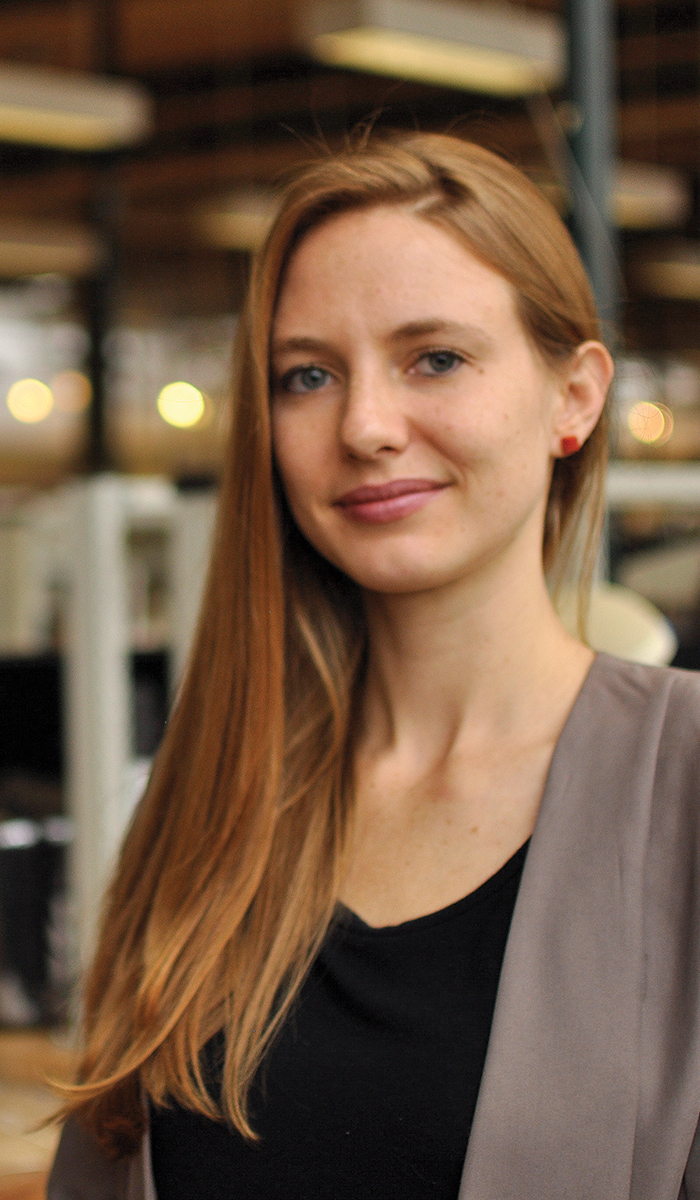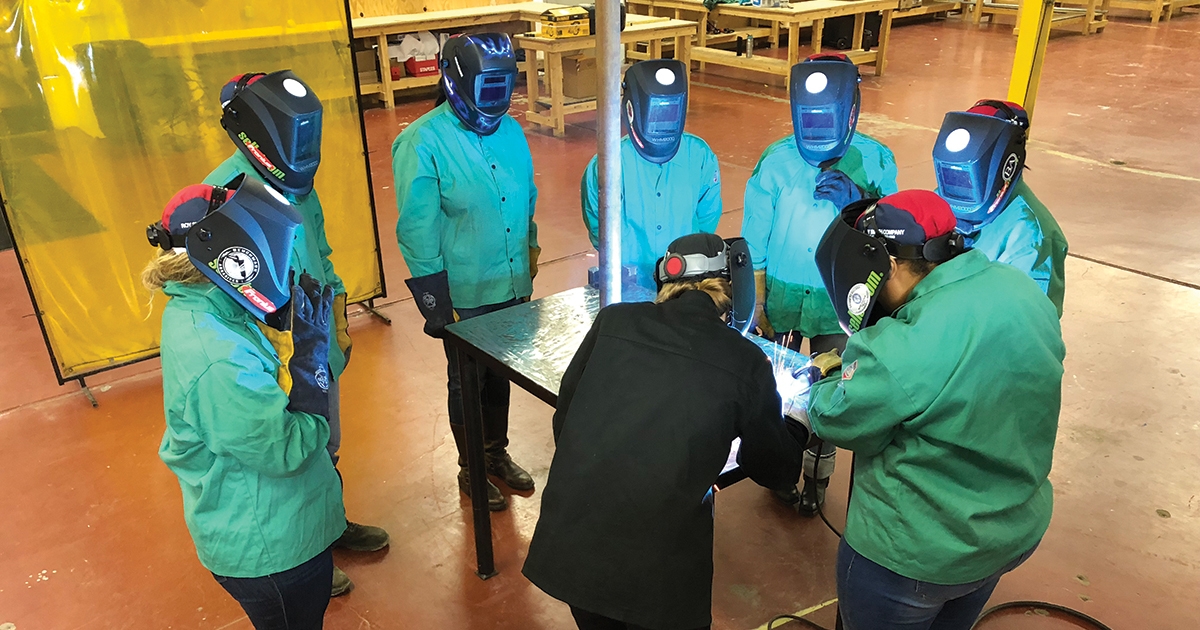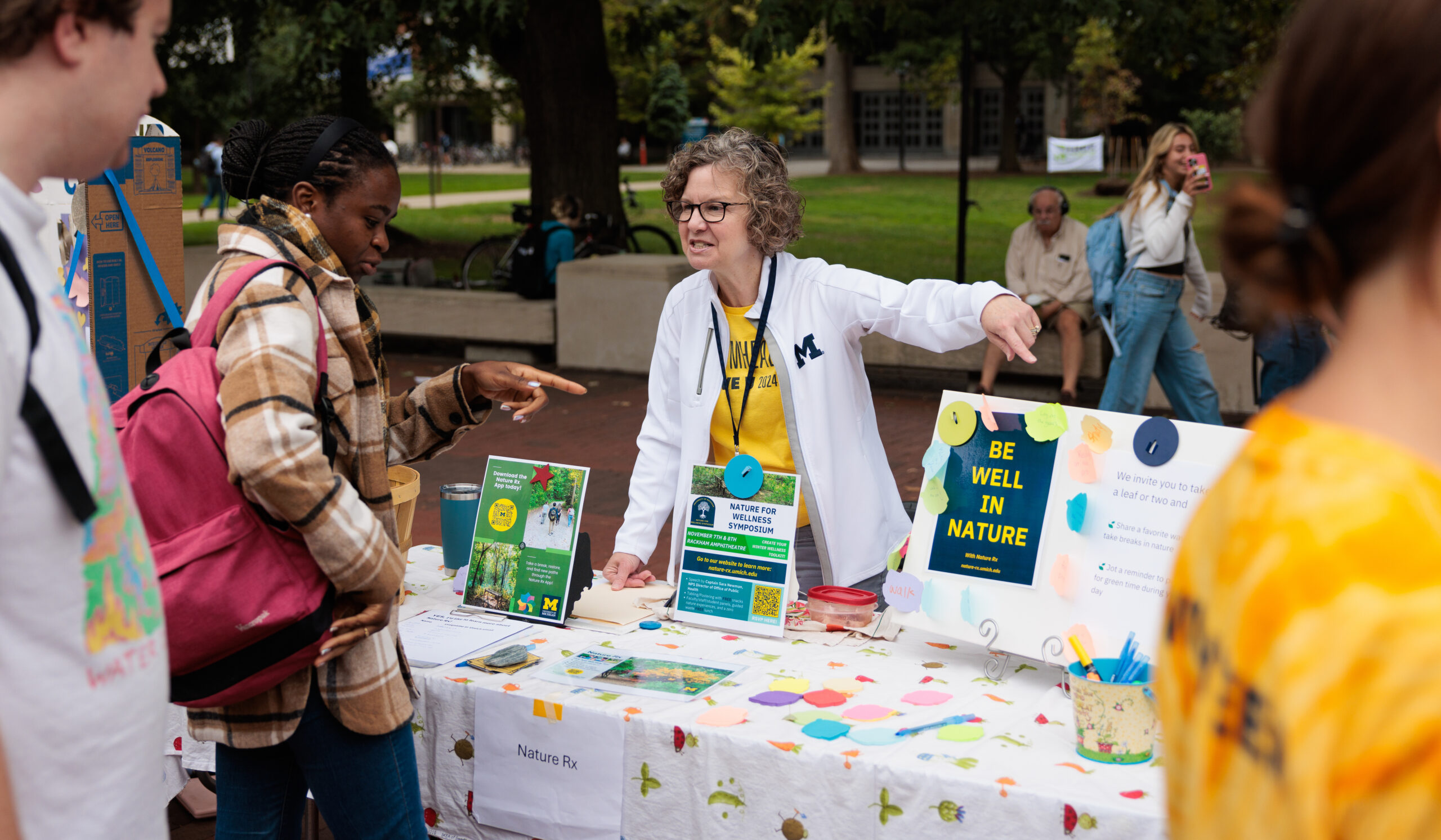Sparks flew, but no one seemed alarmed. Women in flame-resistant green jackets and welding helmets carefully controlled the jets of fire as they practiced moving heat over metal. Every once in a while, a young woman with a long, blonde ponytail peered over their shoulders, holding a helmet to her face and piping in with a tip or a compliment.
For the participants in Women Who Weld’s intensive training program, based in Detroit, there’s no substitute for learning by doing. Welding is creative. It’s physical. It’s dynamic. And participants were not only learning how to use fire and metal to build things, they also were learning how to build careers for themselves.
Women Who Weld is the brainchild of Samantha Farr, MUP’15, the ponytailed woman who brings so much passion to the craft, it’s impossible to leave a conversation with her and not feel inspired by its possibilities. InStyle magazine was among the persuaded when it named Farr, alongside Michelle Obama, Simone Biles, and Gayle King, one of “50 Badass Women Changing the World.”
While many presume that welding is a dying and dated industry, there will be 400,000 job openings for welders by 2025, Farr says. That’s attributable to retirements—the average age of today’s welder is in the mid-50s—and not enough people entering the field. The depleting ranks are at odds with the foundational role of welding in the built environment.
“Anytime you need to join two pieces of metal, you need someone to weld it,” Farr says. Metal furniture, lighting systems, pipes carrying water or gas—“it’s really everywhere,” not least in the transportation, aerospace, defense, and energy industries. Robots are no substitute. They’re affordable only to companies on the scale of General Motors or Ford, and, besides, skilled welders are still needed to program and oversee them.
High school classes once brought people to the profession, but relatively few shop classes exist now. Community colleges help fill the gap, but introductory classes have long waiting lists, creating a bottleneck that stunts enrollment in advanced classes. Meanwhile, only 5.4 percent of welders are women.
“It just didn’t make sense to me that women are not part of this industry that needs people and pays well,” Farr says. “It’s a common misconception that women are not interested; they definitely are. I have a combined wait list of over 400 women, and that’s just locally.”

Farr came to the field in a roundabout way. After working in New York City at a tech startup, she enrolled in U-M’s graduate program in urban planning in the Taubman College, where she focused on economic, community, and workforce development.
She was deep in the books, but “at the same time, I wanted to work with my hands.” On North Campus, where urban planning classes share a building with classes in architecture and art, Farr spied a fabrication lab through the building’s windowed halls. “I thought, ‘How do I get in here?’”
At a one-hour Saturday morning training, Mick Kennedy, who helps run the lab, introduced Farr to the machinery. “Within 20 seconds, I loved it,” she says.
So she created an independent study to learn more, devoting Wednesday mornings to the lab. Her urban planning classmates wondered why she kept going into the “weird, big room,” but soon enough, she emerged with a huge bench that she had made herself.
While the “fab lab” is accessible to all students, Farr noticed that men dominated it. In hopes of sharing the craft she loved with other women, she held the first Women Who Weld program in the summer of 2014. What began as a training in borrowed space from Diseños Ornamental Iron in southwest Detroit has grown into a sturdy young nonprofit. It threads together all that Farr learned along the way, from business development at the startup to an understanding of urban economic forces at U-M. Even her youthful habit of making jewelry with her father, a former gemologist, echoes the work she does today.
More than 200 people have participated in Women Who Weld programs, which boast a 100 percent completion rate. Everyone in the six-week program has had full-time employment secured just after graduation. Earnings start at $15 an hour on average, says Farr, “and then that goes up exponentially.”
Kyle Tripp, a 25-year-old from Connecticut, was working odd jobs after moving to Michigan and says she “had no plans for further education.” She heard about the welding program through a friend and tried a single-day workshop. “Turns out, I loved it,” she says. Like Farr, she finds working with her hands incredibly satisfying.
Tripp then enrolled in the six-week program. “I knew that I needed to make it work so I could completely grab hold of this opportunity and not let it slip away. … I mean, you get a job in the field six weeks after? Hell yes, this is a no-brainer!”
To support such experiences, the scrappy program runs on a mixture of donations, grants, and earned revenue. Fronius, an Austria-based manufacturer, donated about $40,000 worth of machinery. Sustainable funding still remains a challenge, though. It’s disheartening, Farr says, to spend endless hours writing grants that don’t get awarded, in part, she believes, because welding is not seen as “cool,” like, say, coding. “Welding also encompasses all the elements of the STEM fields—science, technology, engineering, and math. It’s misunderstood.”
But Women Who Weld continues to grow. In 2019, it will move into a permanent space in Detroit, which will be tailor-made with the help of a capital grant of more than $24,000 from the American Welding Society.
All this earned Farr “Individual of the Year” at the 2018 Excellence in Welding awards at FABTECH in Atlanta, North America’s largest event for metalwork crafts. Most significantly, it’s earned her the respect of her participants.
“She makes it so easy, easy to get excited about it,” Tripp says. Her Women Who Weld cohort is “one of the best teams I’ve been a part of, even growing up with sports all my life.” They still send well wishes to each other over a group chat.
“You don’t get that camaraderie a lot in a short period,” Tripp says. “But we all went through this life-changing opportunity together. We know how much it means and what it was like to be all sitting in that room knowing our lives are going to change for the better.”
Anna Clark, ’03 is a journalist in Detroit and the author of “The Poisoned City: Flint’s Water and the American Urban Tragedy.”





